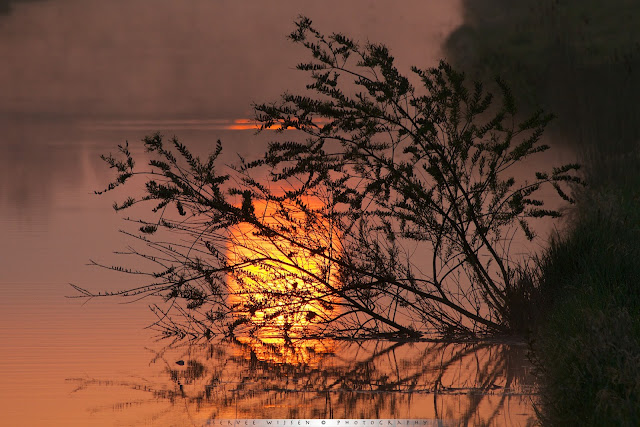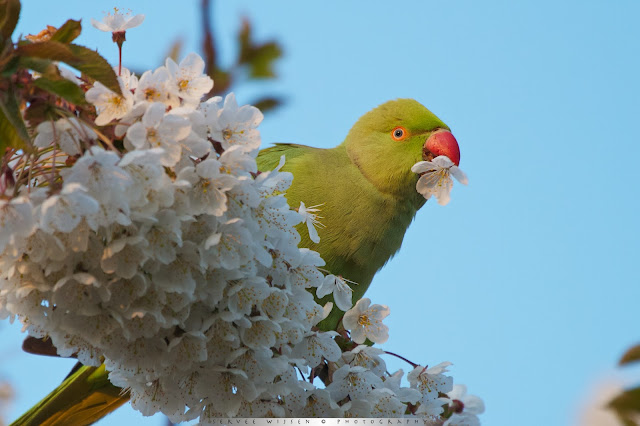Vandaag maar weer eens vroeg uit de veren om de drukte te ontlopen en het mooie licht te vangen en watervogels te fotograferen. Met een plan in mijn hoofd ga ik op pad, maar ik ben nog maar nauwelijks in de polder waneer ik dit plaatje zie. De weerspiegeling van de zon in de vaart is te mooi om niet even voor te stoppen. Leuk dat er toevallig een paar schapen op de dijk staan en ook nog een gans door het beeld vliegt.
---------------------------------------------------------------------------------------------
---------------------------------------------------------------------------------------------
Today I got up early to avoid the crowds and catch some nice light and photograph waterbirds. With a plan in my head I take off, but barely on the road I catch this scene. The reflection of the sun in this canal is to nice not to capture. Nice to have some sheep walking on the dike to have a Goose fly by.
 |
| Zonsopkomst in de Polder - Sunrise in the field |
 |
| Reflectie van de opkomende zon in het water - Reflection of the rising sun in the water |
Bijna op de plaats van bestemming hoor ik een bekend geluid en zie deze Halsbandparkieten zich te goed doen aan de bloesem van een boom in het vroege ochtendlicht. In de jaren 60 werden de eerste Halsbandparkieten losgelaten of ontsnapten uit hun kooi. Ze leven van origine ten noorden van de evenaar in Azië en Afrika. Inmiddels vliegen er in de Randstad duizenden rond, voornamelijk in Den Haag, Rotterdam en Amsterdam, vooral in parken met grote loofbomen. In de winter kunnen ze buiten de steden, als ze niet worden bijgevoerd, maar moeilijk overleven. Het zijn holenbroeders, en hoewel er daardoor sprake is van enige concurrentie met inheemse soorten als Grote Bonte Specht en Boomklever, lijken de meeste zich goed te gedragen, en is het broedsucces laag. Exoot of niet, het is een prachtige vogel!
---------------------------------------------------------------------------------------------
---------------------------------------------------------------------------------------------
Almost at my destination I hear a familiar noise. I look up and see these Ring-necked Parakeets eating the flowers from a tree in the early sunlight. Great! In the Early 60's the first Ring-necked Parakeets were released or escaped on their own from cages. They originate north of the equator in Asia and Africa. Today thousands fly around in The Netherlands, especially in Rotterdam, Amsterdam and The Hague, which holds the largest population. Mostly in Parks which have big foliage trees. In winter it's hard to survive outside cities for this tropical bird if it isn't fed by humans. They breed in holes, especially made by Great Spotted woodpeckers. So they might be competitors for these birds and others, like Nuthatches, or even Owls. But they seem t o behave fairly non-invasive and friendly most of the time and breeding success is low. Even though it's not native, it's a beautiful bird!
 |
| Halsbandparkiet - Ring-necked Parakeet - Psittacula krameri |
 |
 |
 |
Maar goed, hier kwam ik dus niet voor, Ik was op zoek naar de schuwe Purperreiger. Ze broeden hier in de buurt, en ik zag er al een paar op afstand overvliegen, maar het is moeilijk ze op lokatie te spotten omdat ze zo goed gecamoufleerd zijn en al opvliegen voor je ze gezien hebt. Voor ik het wist vlogen er twee op honderd meter voor me uit toen ik het weiland in stapte. Dat ze zo schuw zijn is niet zo vreemd want deze vogels worden helaas nog steeds bejaagd en gegeten in hun overwinteringsgebieden in West Afrika. Maar deze twee leken eerder boos dat ik ze gestoord had en bleven al krijsend een paar rondjes boven mij vliegen.
---------------------------------------------------------------------------------------------
But anyway, this was not the species I expected to see. I came for the elusive Purple Heron. They breed here, but are hard to catch on site because they're very shy birds and hey see you coming well before you see them because of their great camouflage. And of course I was running late because of the before mentioned distractions. I saw a few flying already at a great distance, an before I new it, two flew up a hundred meters before me as I entered the field. It's understandable that these birds are so shy of people because they're still hunted and eaten by people in their winter habitats in West Africa.
 |
| Purperreiger - Purple Heron - Ardea purpurea |
 |
 |
 |
Vervolgens zag ik een paar Regenwulpen overvliegen die net als de grotere Wulp een kromme, maar veel kortere snavel heeft. Hij is beter herkenbaar aan de contrasterende donkere oogstreep.
---------------------------------------------------------------------------------------------
Next I saw a couple of Whimbrels fly by. Like the larger Curlew it has a curved, but much shorter beak. Also it's head is has a recognizable dark eye stripe.
 |
Regenwulp - Whimbrel - Numenius phaeopus
|
Een andere soort die ik hoopte te 'vangen' is de Bruine Kiekendief die hier broed en jaagt. Hij liet zich een hele tijd niet zien tot dit mannetje recht op me af kwam vliegen en recht over me heen vloog. Niet de meest geweldige foto. Je hoopt ze op typische wijze te zien jagen, laag boven het riet, maar deze vogel was blijkbaar nieuwsgierig naar mij en keek even op me neer alvorens door te vliegen.
---------------------------------------------------------------------------------------------
Another species I hoped to 'capture' was the Marsh Harrier, which breeds and hunts in this area. It didn't show for a while until this male came straight at me and flew right over my head. Not the greatest picture. One hopes to see it hunting low above the reed in it's typical way, but this one clearly was curious for 'what' was sitting there on the path. and came to have look before flying along.
 |
| Bruine Kiekendief - Marsh Harrier - Circus Aeruginosus |
 |
| Slobeend - Northern Shoveler - Anas clypeata |
Ook hoor ik het typische geroep van het Baardmannetje. In de winter te zien in grote groepen, maar 's zomers varanderen ze van een zaden dieet naar insecten en zitten ze laag verborgen tussen het riet. Dit vrouwtje zat vlak langs het pad. Zie mijn eerdere post voor meer en mooiere foto's van dit prachtige vogeltje.
---------------------------------------------------------------------------------------------
I also hear the typical call of the Bearded Reedling. In Winter they can be seen in large groups eating seeds. In spring they are harder to see as they switch their diet to insects and disappear in the reed. This female was close to the path along the reedfield. See my earlier post for more and better pictures of this beautiful bird.
 |
| Baardmannetje - Bearded Reedling - Panurus biarmicus |
Alles leek vanochtend wel tegen de zon in te vliegen, zo ook deze Lepelaar.
---------------------------------------------------------------------------------------------
Everything seemed to fly against the sun this morning, so did this Spoonbill.
 |
| Lepelaar - Spoonbill - Plataleo Leucorodia |
 |
| Reebok verscholen tussen het riet - Roe Deer hidden in the reed |
 |
| Broedende Kievit - Breeding Lapwing |
Op de weg terug ga ik nog even langs het meer waar de Purperreigers broeden. De kolonie zit aan de overkant van het water in het riet verscholen. Met een verrekijker of telescoop kun je de nesten zien.
---------------------------------------------------------------------------------------------
On the way back home I stop at the lake where the Purple Herons breed. The colony is across the water in the Reedfields. You can see the nesting birds with binoculars or telescope.
 |
| Purperreiger nesten aan de overkant van het water - Purple heron nests across the lake |
Tijd voor koffie!
---------------------------------------------------------------------------------------------
Time for coffee!
Greetzzzz, Servee
Geen van deze foto's mag zonder mijn schriftelijke toestemming worden gebruikt voor publicatie of welk ander doel dan ook. Een link naar deze pagina is uiteraard wel toegestaan. Neem voor meer informatie contact op via mijn website www.serveewijsen.com
-----------------
None of the contents or photos published here may be used for publication or any other purposes without my written permission. linking to this page is permitted. For more information on using these images please contact me through my website www.serveewijsen.com
MIJN PORTFOLIO STAAT HIER!
• • • • (c) Servee Wijsen 2013 • • • •

Geen opmerkingen:
Een reactie posten